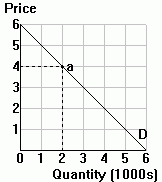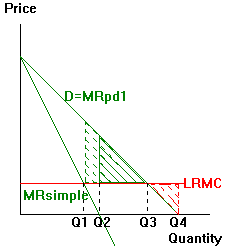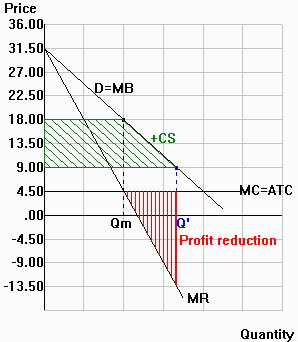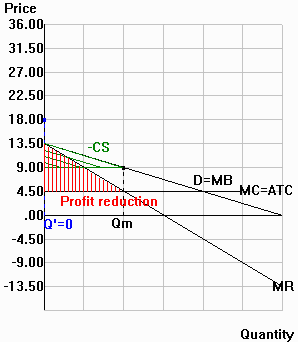| 1. |
The Museum of Fine Arts (MFA) in Boston normally
charges $4 for admission. Suppose that the number of MIT students who visit the MFA is
given by: Q = 6000 - 1000P and that the marginal cost of additional visitors is 0. |
 |
|
a. |
Draw MIT's demand curve in the diagram to the
right, and depict the equilibrium situation with the regular $4 admission price.
See diagram |
|
b. |
Why might it be reasonable to assume that MC=0?
Most of the costs are fixed: buildings, exhibits.
Even staffing doesn't change much with number of patrons, so MC of another
patron is close to zero. |
|
Consider two alternative ways of charging MIT
students for admission to the MFA:
Option A: Charge the normal price of $4.
Option B: Collect a lump sum payment of $10,000 from MIT (financed by
MIT out of student tuition revenues) and grant MIT students free admission. |
|
c. |
Complete the following table comparing the two
options: |
|
|
|
| |
(1) |
(2) |
(3) |
| Option A |
Option B |
Change (2) - (1) |
| Consumer surplus |
$2,000 |
$8,000 |
+$6,000 |
| Producer surplus |
$8,000 |
$10,000 |
+$2,000 |
| Combined (market surplus) |
$10,000 |
$18,000 |
+8,000 |
|
|
d. |
How is it possible for Option B to make both
MIT students and the MFA better off compared to Option A?
Option B eliminates the $8,000
welfare loss from underconsumption. With P=$4, only 2,000 people go to the
museum.With P=$0, 6,000 people go, raising total welfare by $8,000. |
| |
|
|
|
|



